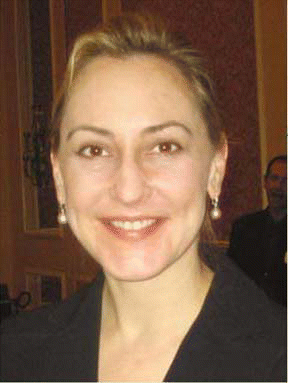NAPLES, Fla.-The use of positron emission tomography (PET) is not sensitive enough to warrant routine use in post-curative chemoradiation therapy diagnosis of patients with node-positive head and neck cancer, according to researchers in the field.
Explore This Issue
April 2006At least two recent studies have shown that after chemoradiotherapy, neck dissections indicate that as many as 38% of patients have residual cervical metastatic disease.
The use of computer-assisted tomography (CT) in evaluating patients following the node-positive neck after organ preservation therapy has been unreliable, said Victoria S. Brkovich, MD, a resident in the Department of Otolaryngology at the University of Texas Health Science Center at San Antonio.
In delivering the G. Slaughter Fitz-Hugh Resident Research Award here at the Southern Section Meeting of the Triological Society, Dr. Brkovich said that studies with CT show that the images have a sensitivity of 85%, specificity of 24%, and positive predictive value of 40%.
With those shortcomings in mind, some researchers have looked to PET imaging to predict residual cervical metastatic disease after treatment with chemoradiotherapy.
A significant number of head and neck squamous cell carcinoma with N2 or N3 disease harbor residual metastases despite an apparent clinical response. – -Christine Gourin, MD
Why Use PET to Detect Cancer
She explained that when patients are injected with the positron-emitting radionucleotide 18-fluorodeoxyglucose (FDG), the radionucleotide is taken up in cells by glucose transporters. Its distribution is a measure of glucose metabolism.
Because neoplasms generally demonstrate increased glucose metabolism, the uptake of 18-FDG PET may detect and localize a viable tumor.
In her study, Dr. Brkovich recruited 21 patients in a prospective case series in 2004 and 2005 who had undergone curative surgery and chemoradiation for squamous cell cancer of the head and neck. To be included in the study, patients had to have had biopsy-proven squamous cell carcinoma of the upper aerodigestive tract, node-positive neck disease, completion of the chemotherapy or chemoradiation protocol, a complete response at the tumor site, a post-treatment PET scan, and salvage neck dissection.
The sensitivity, specificity, and positive and negative predictive values were calculated based on the comparison of the PET scan result and the histopathological result of the corresponding neck dissection sample, she said.
Results Lacking Specificity, Sensitivity
The histopathological report found four neck dissections were positive for residual squamous cell carcinoma and the other 17 specimens were negative.
Dr. Brkovich said there were three true positive PET studies and one false negative PET study among the four specimen-positive findings. There were 11 true negative PET studies and 6 false positive PET studies.
That resulted in a calculation that, in this study, PET had a sensitivity of 75%; a specificity of 65%; a positive predictive value of 33%; and a negative predictive value of 92%, Dr. Brkovich said.
While the role of the post-treatment neck dissection remains controversial, the surgeon must rely on a combination of clinical examination and imaging studies, Dr. Brkovich said. Our practice has been to perform a planned staged neck dissection on all N2/N3 necks as well as N1 necks with an incomplete response to treatment.
Based on this small prospective study it appears that PET imaging lacks adequate sensitivity and specificity to reliably predict the presence of residual metastatic disease after treatment.
However, Dr. Brkovich said that even though the numbers are small PET imaging may be a valuable guide to the surgeon. The negative PET scan may allow the surgeon to avoid a post-treatment neck dissection.
Based on this small prospective study it appears that PET imaging lacks adequate sensitivity and specificity to reliably predict the presence of residual metastatic disease after treatment. – -Victoria S. Brkovich, MD
Dr. Brkovich noted that her study is limited by the small numbers of patients, the lack of a pre-treatment baseline PET imaging studies, and the possibility that researchers used poor timing in scheduling post-treatment PET studies.
PET-CT Combination
In a similar study, Christine Gourin, MD, Assistant Professor of Otolaryngology at the Medical College of Georgia in Augusta, considered whether the combination of PET and CT could be useful in identifying nodal disease following chemoradiation for advanced head and neck cancer.
The need for a less invasive procedure than neck dissection exists because the dissection is often planned following primary chemoradiation in patients with head and neck squamous cell cancer who demonstrate a complete response.
The need for dissection in these patients is controversial. In competing papers in 2004, one author suggested that everyone who survived chemoradiation needed the dissection to help plan post-treatment therapy. The second author suggested in his paper that only less than a complete response required a neck dissection.
We sought to investigate the utility of PET-CT in identifying patients with occult nodal disease following a complete response, Dr. Gourin said in her oral presentation at the Triological Society Meeting.
Dr. Gourin suggested that the PET-CT combination-which produces sharper images-could give doctors the information required to determine if the surgery was needed.
Insufficiency Specificity, Sensitivity
She reviewed the medical records of patients treated with primary chemoradiation for advanced head and neck squamous cell carcinoma with N2 or N3 disease from December 2003 through June 2005. Dr. Gourin found 17 patients who were irradiated with 7032 centiGray in once daily fractions over a seven week period during which nine patients received cisplatin and eight patients were treated with cisplatin and 5-flourouracil. The 17 patients achieved total responses and underwent planned neck dissection at 10 to 12 months. At 8 to 10 weeks post-treatment, the patients underwent a PET-CT imaging study.
When the studies were compared to histopathological results, Dr. Gourin found that PET-CT had a sensitivity of 40%, a specificity of 25%, a positive predictive value of 18%, and a negative predictive value of 50%.
These results show that a significant number of head and neck squamous cell carcinoma with N2 or N3 disease harbor residual metastases despite an apparent clinical response, Dr. Gourin said.
PET-CT is not sufficiently specific or sensitive to predict need for post-treatment neck dissection in this population, she said.
Dr. Gourin, however, suggested that increasing the contrast agent used in the imaging process might substantially increase the specificity and sensitivity of the PET-CT combination.
©2006 The Triological Society


Leave a Reply